Training, Control and Application of SMA-Based Actuators with Two-Way Shape Memory Effect
Abstract
:1. Introduction
2. SMA-Based Actuator with TWSME
2.1. Heat Treatment and Material Parameter Tests
2.2. Training Methods and Training Test
2.3. Deformation Test for the SMA-Based Actuator
3. Hysteresis Modeling
3.1. Preisach Model
3.2. Numerical Simulation
3.3. Identification
3.4. Design of Control System
4. Experimental Results
5. Conclusions
Author Contributions
Funding
Institutional Review Board Statement
Informed Consent Statement
Data Availability Statement
Conflicts of Interest
Glossary
| u(t) | Signal input |
| y(t) | Preisach model output |
| Preisach density function | |
| Hysteresis operator | |
| Hysteresis operator corresponds to ‘up’ switching values of input | |
| Hysteresis operator corresponds to ‘down’ switching values of input | |
| Peaks of the previous input signal | |
| Valleys of the previous input signal | |
| e(t) | Error signal |
| yd(t) | Setpoint signal |
| y(t) | Process variable |
| u(t) | Control signal |
| e(n) | Error at time instant (n) |
| u(n) | Control output at time instant (n) |
| kp | Proportional gain |
| ki | Integral gain |
| kd | Derivative gain |
References
- Barbarino, S.; Bilgen, O.; Ajaj, R.M.; Friswell, M.I.; Inman, D.J. A Review of Morphing Aircraft. J. Intell. Mater. Syst. Struct. 2011, 22, 823–877. [Google Scholar] [CrossRef]
- Liu, B.; Liang, H.; Han, Z.-H.; Yang, G. Surrogate-based aerodynamic shape optimization of a morphing wing considering a wide Mach-number range. Aerosp. Sci. Technol. 2022, 124, 107557. [Google Scholar] [CrossRef]
- McGowan, A.-M.R.; Pitt, D.M.; Dunne, J.P.; White, E.V. SAMPSON smart inlet design overview and wind tunnel test: I. Design overview. In Proceedings of the Smart Structures and Materials 2002: Industrial and Commercial Applications of Smart Structures Technologies, San Diego, CA, USA; 2002; pp. 13–23. [Google Scholar]
- Zhang, C.; Liu, R.; Tao, C.; Zhang, C.; Ji, H.; Qiu, J. Design, construction, and modeling of aircraft door sealing plate based on SMAs. Int. J. Smart Nano Mater. 2022, 13, 481–503. [Google Scholar] [CrossRef]
- Andonovski, B.; Wang, J. Computer Vision System for Cabin Door Detection and Location. In Proceedings of the 2018 15th International Conference on Control, Automation, Robotics and Vision (ICARCV), Singapore, 18–21 November 2018; pp. 1537–1542. [Google Scholar]
- Hu, K.; Rabenorosoa, K.; Ouisse, M. A Review of SMA-Based Actuators for Bidirectional Rotational Motion: Application to Origami Robots. Front. Robot. AI 2021, 8, 678486. [Google Scholar] [CrossRef]
- Monner, H.; Kintscher, M.; Lorkowski, T.; Storm, S. Design of a Smart Droop Nose as Leading Edge High Lift System for Transportation Aircrafts. In Proceedings of the 50th AIAA/ASME/ASCE/AHS/ASC Structures, Structural Dynamics, and Materials Conference, Palm Springs, CA, USA, 4–7 May 2009. [Google Scholar]
- Jinks, E.R.; Bruce, P.J.; Santer, M.J. Adaptive Shock Control Bumps. In Proceedings of the 52nd Aerospace Sciences Meeting, National Harbor, MD, USA, 13–17 January 2014. [Google Scholar]
- Bahl, S.; Nagar, H.; Singh, I.; Sehgal, S. Smart materials types, properties and applications: A review. Mater. Today Proc. 2020, 28, 1302–1306. [Google Scholar] [CrossRef]
- Kumar, P.K.; Lagoudas, D.C. Introduction to Shape Memory Alloys. In Shape Memory Alloys: Modeling and Engineering Applications; Springer Science+Business Media Deutschland GmbH: Berlin, Germany, 2008; pp. 1–51. Available online: http://www.springer.com (accessed on 15 November 2022). [CrossRef]
- Otsuka, K.; Wayman, C. Shape Memory Materials; Cambridge University Press: Cambridge, UK, 1998; p. 284. [Google Scholar]
- Bhaskar, J.; Sharma, A.K.; Bhattacharya, B.; Adhikari, S. A review on shape memory alloy reinforced polymer composite materials and structures. Smart Mater. Struct. 2020, 29, 073001. [Google Scholar] [CrossRef]
- Mohd Jani, J.; Leary, M.; Subic, A.; Gibson, M.A. A review of shape memory alloy research, applications and opportunities. Mater. Des. 2014, 56, 1078–1113. [Google Scholar] [CrossRef]
- Barbarino, S.; Saavedra Flores, E.I.; Ajaj, R.M.; Dayyani, I.; Friswell, M.I. A review on shape memory alloys with applications to morphing aircraft. Smart Mater. Struct. 2014, 23, 063001. [Google Scholar] [CrossRef]
- Stroud, H.; Hartl, D. Shape memory alloy torsional actuators: A review of applications, experimental investigations, modeling, and design. Smart Mater. Struct. 2020, 29, 113001. [Google Scholar] [CrossRef]
- Hao, L.; Qiu, J.; Ji, H.; Nie, R. Numerical analysis on shape memory alloy–based adaptive shock control bump. J. Intell. Mater. Syst. Struct. 2018, 29, 3055–3066. [Google Scholar] [CrossRef]
- Calkins, F.T.; Mabe, J.H. Shape Memory Alloy Based Morphing Aerostructures. J. Mech. Des. 2010, 132, 111012. [Google Scholar] [CrossRef]
- Dana, M.E.; Aarash Yusefzadeh Nagh, S.; Haydn, N.G.W. A bio-inspired high-authority actuator for shape morphing structures. In Smart Structures and Materials 2003: Active Materials: Behavior and Mechanics; SPIE: Bellingham, WA, USA, 2003; pp. 92–100. [Google Scholar]
- Wang, Z.; Yang, X.; Li, B. SMA-actuated Morphing Wing with Varying Spanwise Curvature and SweptAngle. In Proceedings of the 2019 IEEE International Conference on Robotics and Biomimetics (ROBIO), Dali, China, 6–8 December 2019; pp. 1615–1620. [Google Scholar] [CrossRef]
- Auricchio, F.; Boatti, E.; Conti, M.; Marconi, S. Chapter 19—SMA biomedical applications. In Shape Memory Alloy Engineering, 2nd ed.; Concilio, A., Antonucci, V., Auricchio, F., Lecce, L., Sacco, E., Eds.; Butterworth-Heinemann: Boston, MA, USA, 2021; pp. 627–658. [Google Scholar] [CrossRef]
- Luji, F.F.J.; Teo, K.T.; Tan, S.; Yoong, H. Heating and Cooling Mechanisms for SMA Actuator-A Brief Review. Trans. Sci. Technol. 2021, 8, 425–431. [Google Scholar]
- Zhang, C.; Ji, H.; Chen, X.; Qiu, J. Thermomechanical training and structural tests for adaptive SMA bumps with two-way shape memory effect. J. Intell. Mater. Syst. Struct. 2021, 33, 1308–1320. [Google Scholar] [CrossRef]
- Jayender, J.; Patel, R.V.; Nikumb, S.; Ostojic, M. Modeling and Control of Shape Memory Alloy Actuators. IEEE Trans. Control Syst. Technol. 2008, 16, 279–287. [Google Scholar] [CrossRef]
- Ahn, K.K.; Kha, N.B. Modeling and control of shape memory alloy actuators using Preisach model, genetic algorithm and fuzzy logic. Mechatronics 2008, 18, 141–152. [Google Scholar] [CrossRef]
- Mitrev, R.; Todorov, T.; Fursov, A.; Ganev, B. Theoretical and Experimental Study of a Thermo-Mechanical Model of a Shape Memory Alloy Actuator Considering Minor Hystereses. Crystals 2021, 11, 1120. [Google Scholar] [CrossRef]
- Webb, G.V.; Lagoudas, D.C.; Kurdila, A.J. Hysteresis modeling of SMA actuators for control applications. J. Intell. Mater. Syst. Struct. 1998, 9, 432–448. [Google Scholar] [CrossRef]
- Ikhouane, F. A Survey of the Hysteretic Duhem Model. Arch. Comput. Methods Eng. 2018, 25, 965–1002. [Google Scholar] [CrossRef]
- Chun-Yi, S.; Qingqing, W.; Xinkai, C.; Rakheja, S. Adaptive variable structure control of a class of nonlinear systems with unknown Prandtl-Ishlinskii hysteresis. IEEE Trans. Autom. Control 2005, 50, 2069–2074. [Google Scholar] [CrossRef]
- Wang, Z.G.; Zu, X.T.; Feng, X.D.; Lin, L.B.; Zhu, S.; You, L.P.; Wang, L.M. Design of TiNi alloy two-way shape memory coil extension spring. Mater. Sci. Eng. A 2003, 345, 249–254. [Google Scholar] [CrossRef]
- Otsuka, K.; Ren, X. Recent developments in the research of shape memory alloys. Intermetallics 1999, 7, 511–528. [Google Scholar] [CrossRef]
- Luo, H.Y.; Abel, E.W. A comparison of methods for the training of NiTi two-way shape memory alloy. Smart Mater. Struct. 2007, 16, 2543–2549. [Google Scholar] [CrossRef]
- Yan, L.; Liu, Y. Wear Behavior of Austenitic NiTi Shape Memory Alloy. Shape Mem. Superelasticity 2015, 1, 58–68. [Google Scholar] [CrossRef] [Green Version]
- Preisach, F. ber die magnetische Nachwirkung. Z. Phys. 1935, 94, 277–302. [Google Scholar] [CrossRef]
- Tang, Z.-f.; Lv, F.-z.; Xiang, Z.-q. Hysteresis model of magnetostrictive actuators and its numerical realization. J. Zhejiang Univ.-Sci. A 2007, 8, 1059–1064. [Google Scholar] [CrossRef]
- Jung, J.-K.; Park, Y.-W. Hysteresis modeling and compensation in a magnetostrictive actuator. In Proceedings of the 2008 International Conference on Control, Automation and Systems, Seoul, Republic of Korea, 14–17 October 2008. [Google Scholar] [CrossRef]
- Crowe, J.; Tan, K.; Lee, T.; Ferdous, R.; Katebi, M.; Huang, H.-P.; Jeng, J.-C.; Tang, K.; Chen, G.; Man, K.; et al. PID Control: New Identification and Design Methods; Michael, A., Johnson, M.H.M., Eds.; Springer: London, UK, 2005; Volume XXVIII, p. 544. [Google Scholar] [CrossRef]
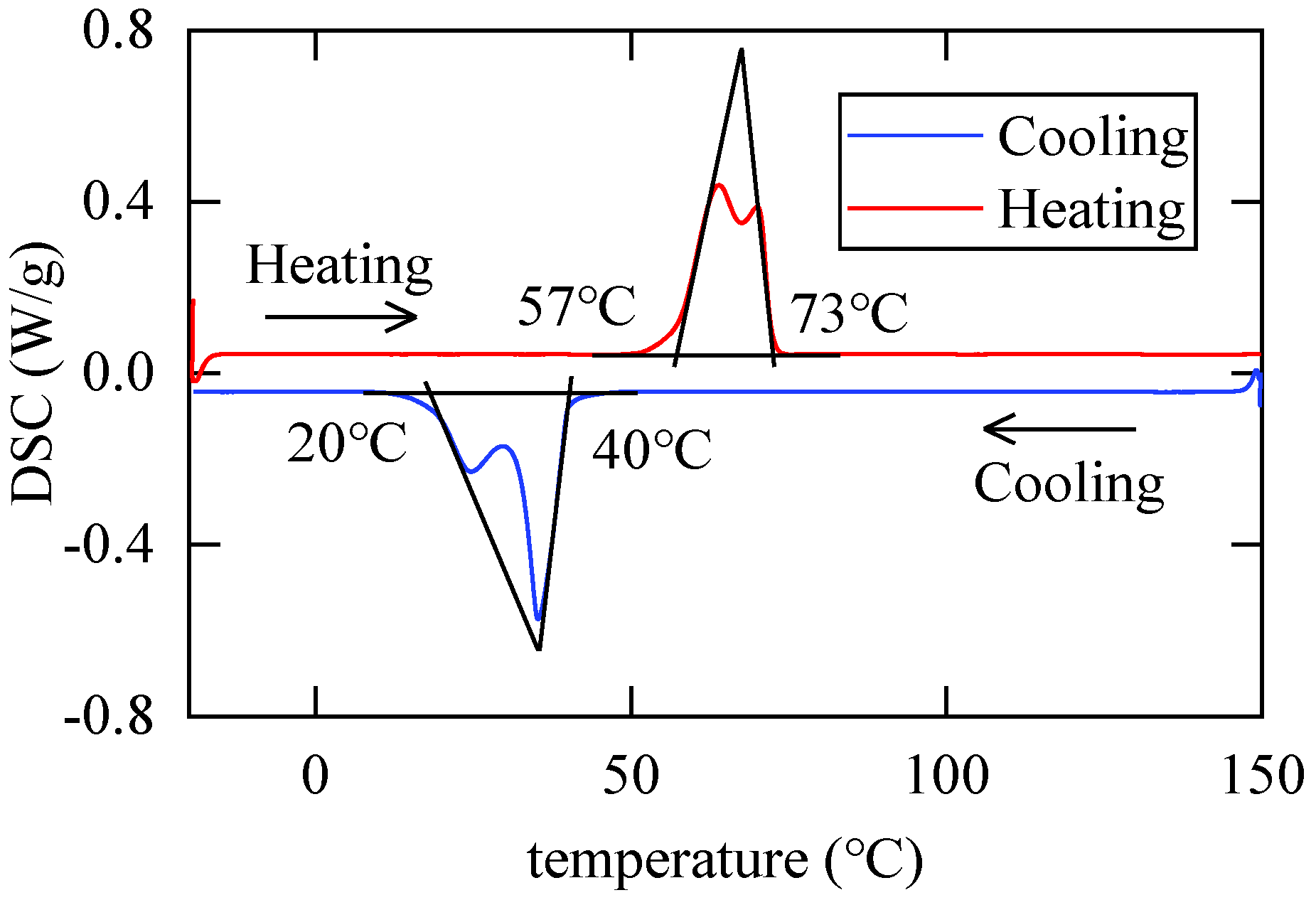

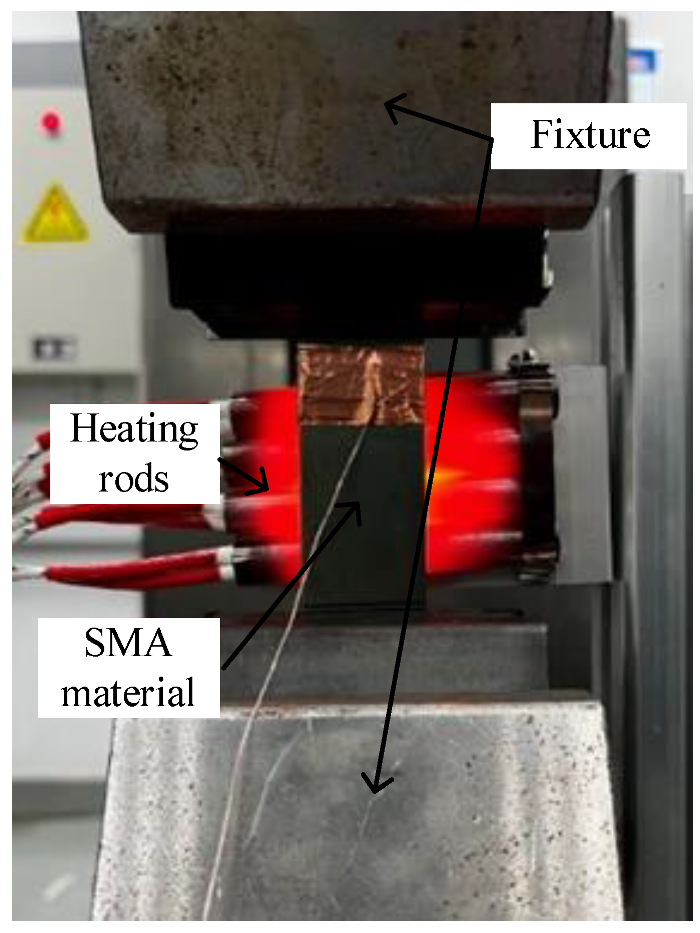
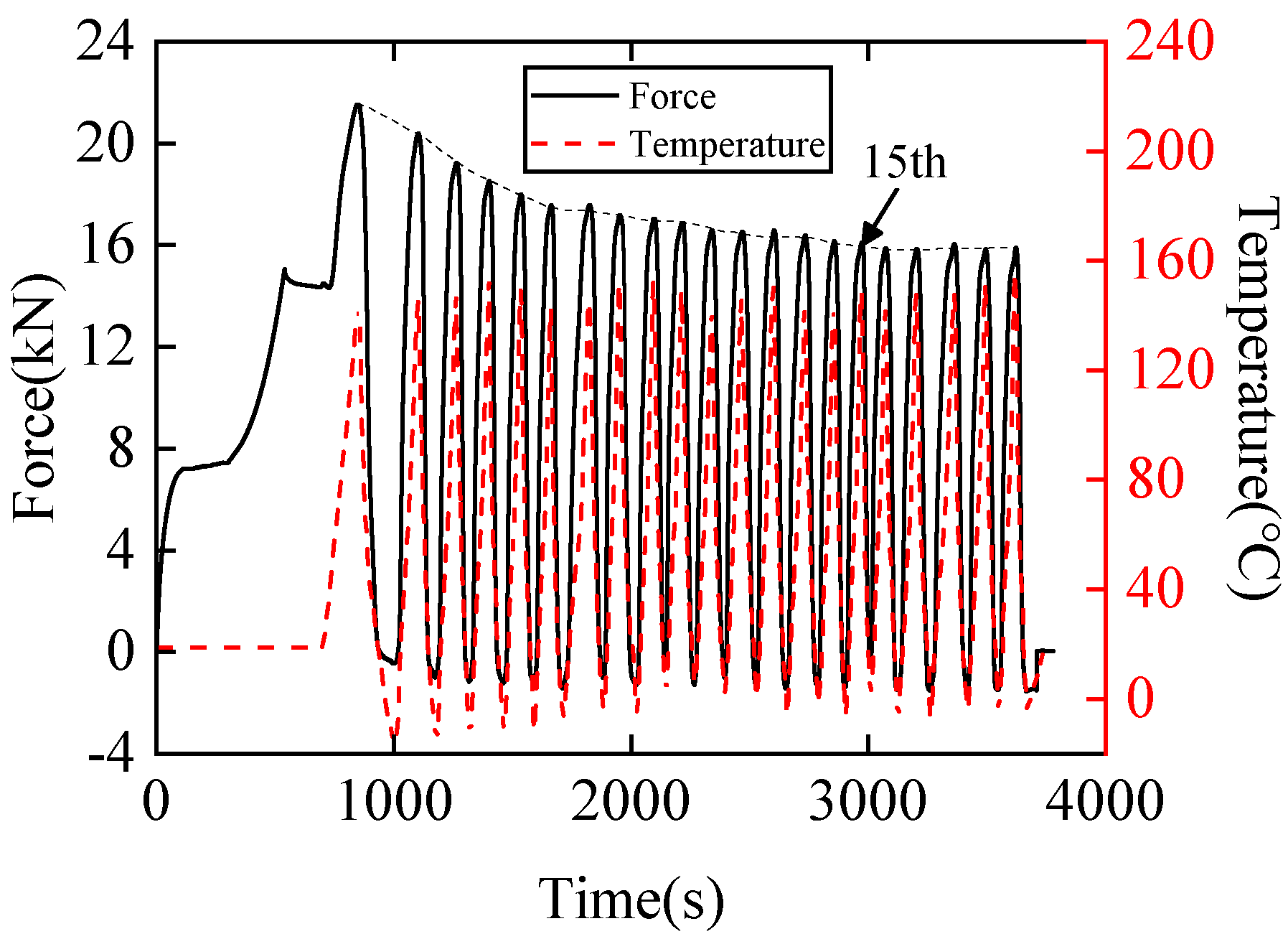
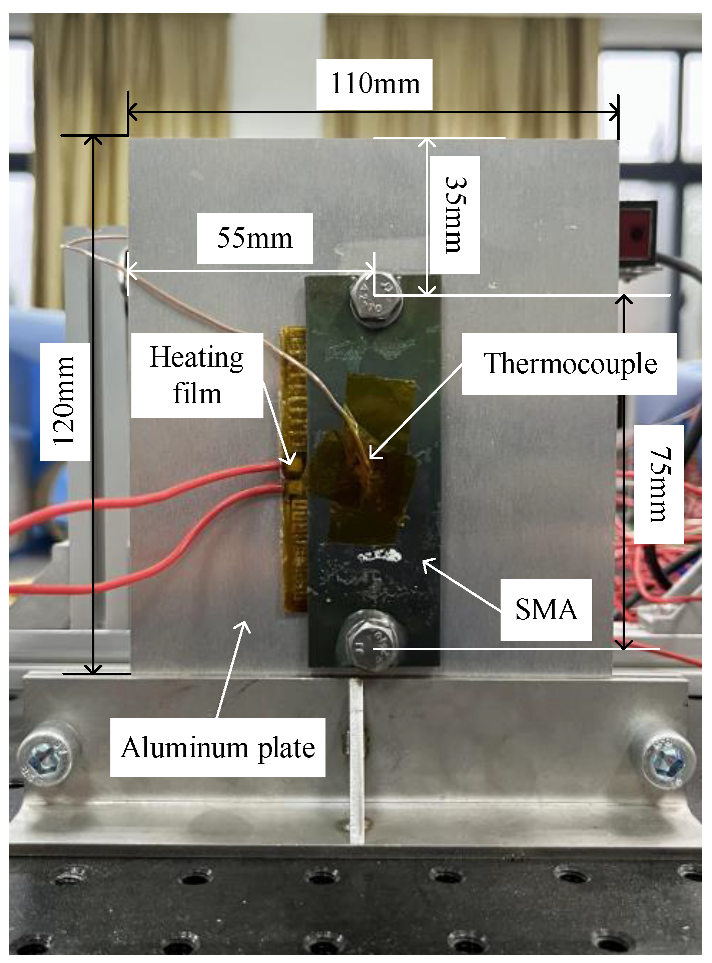

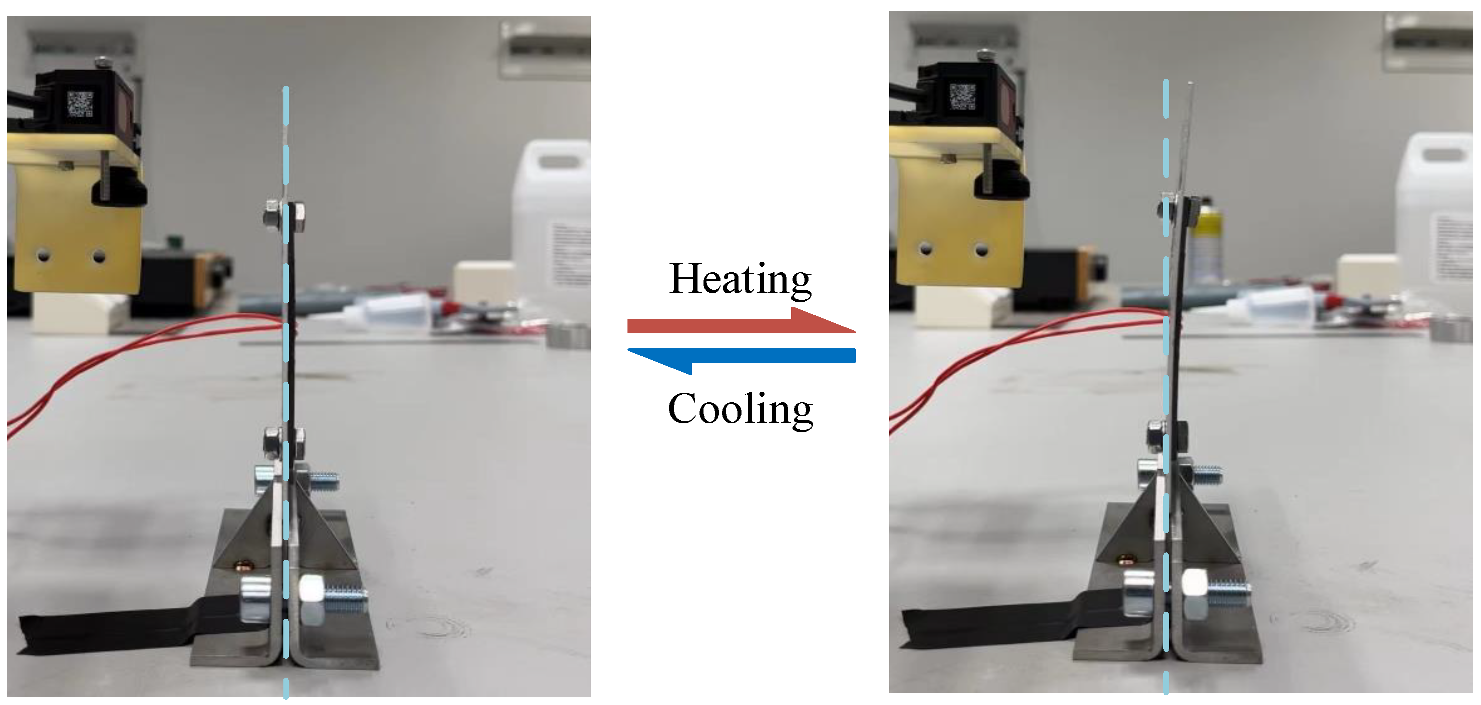

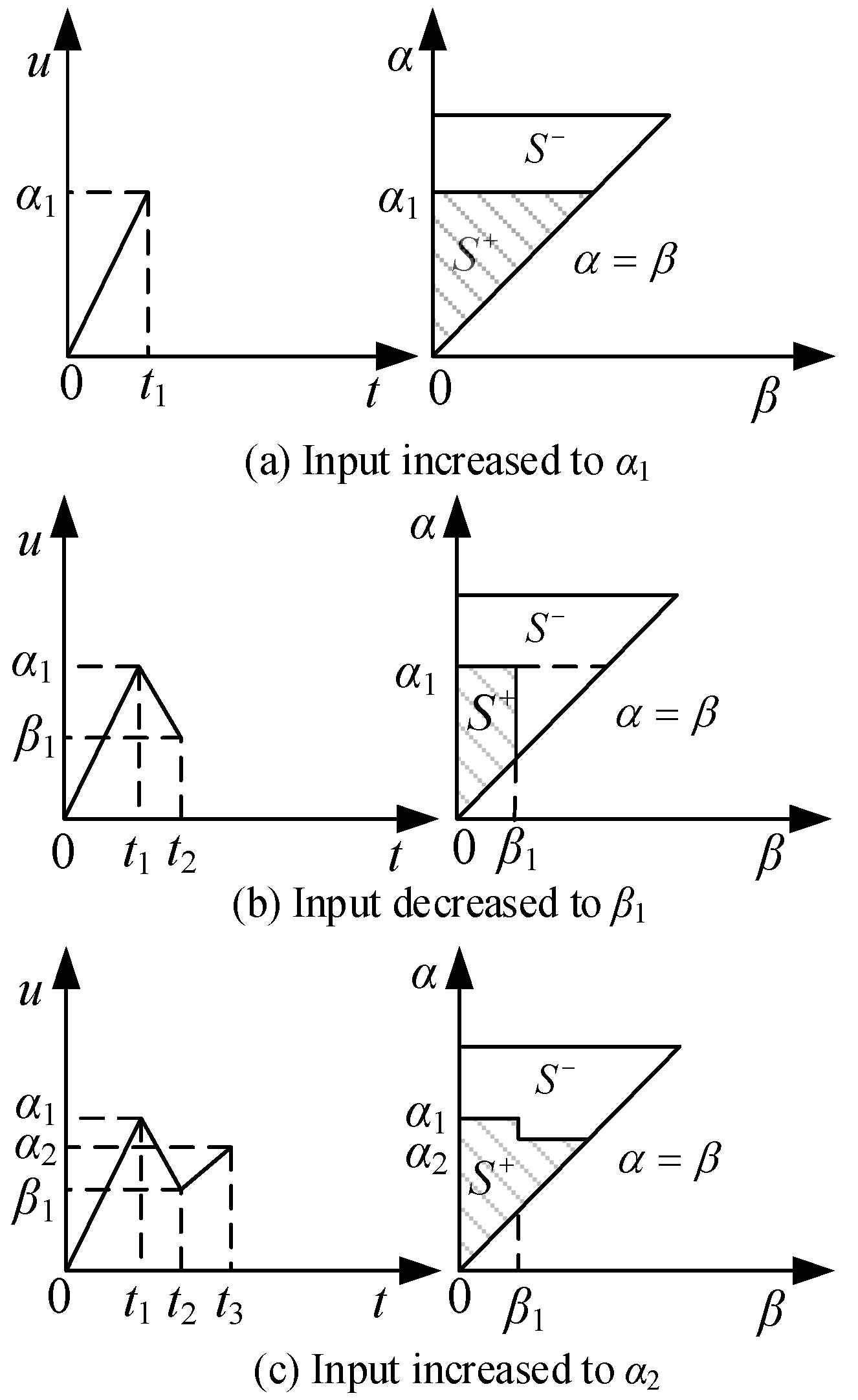
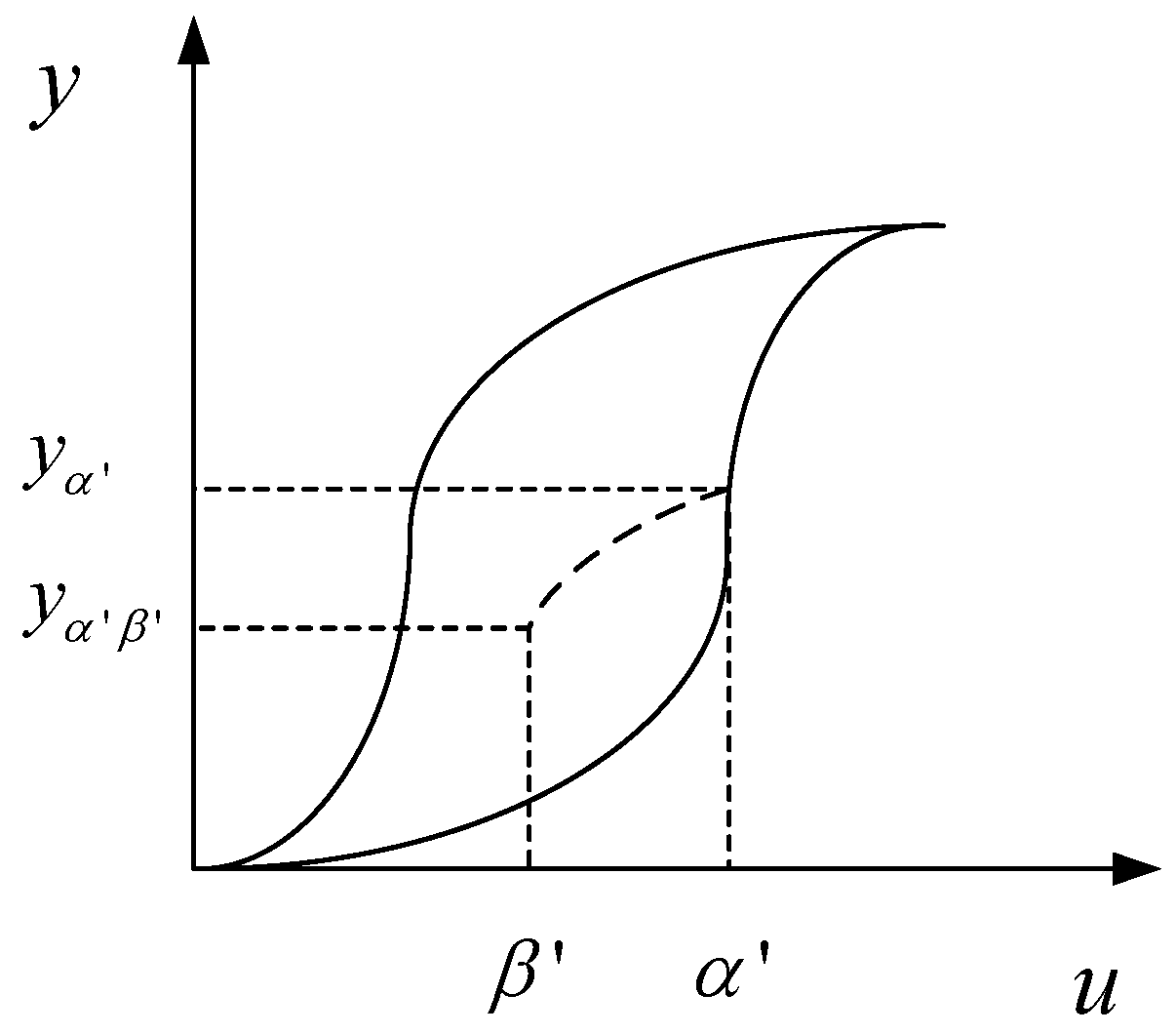
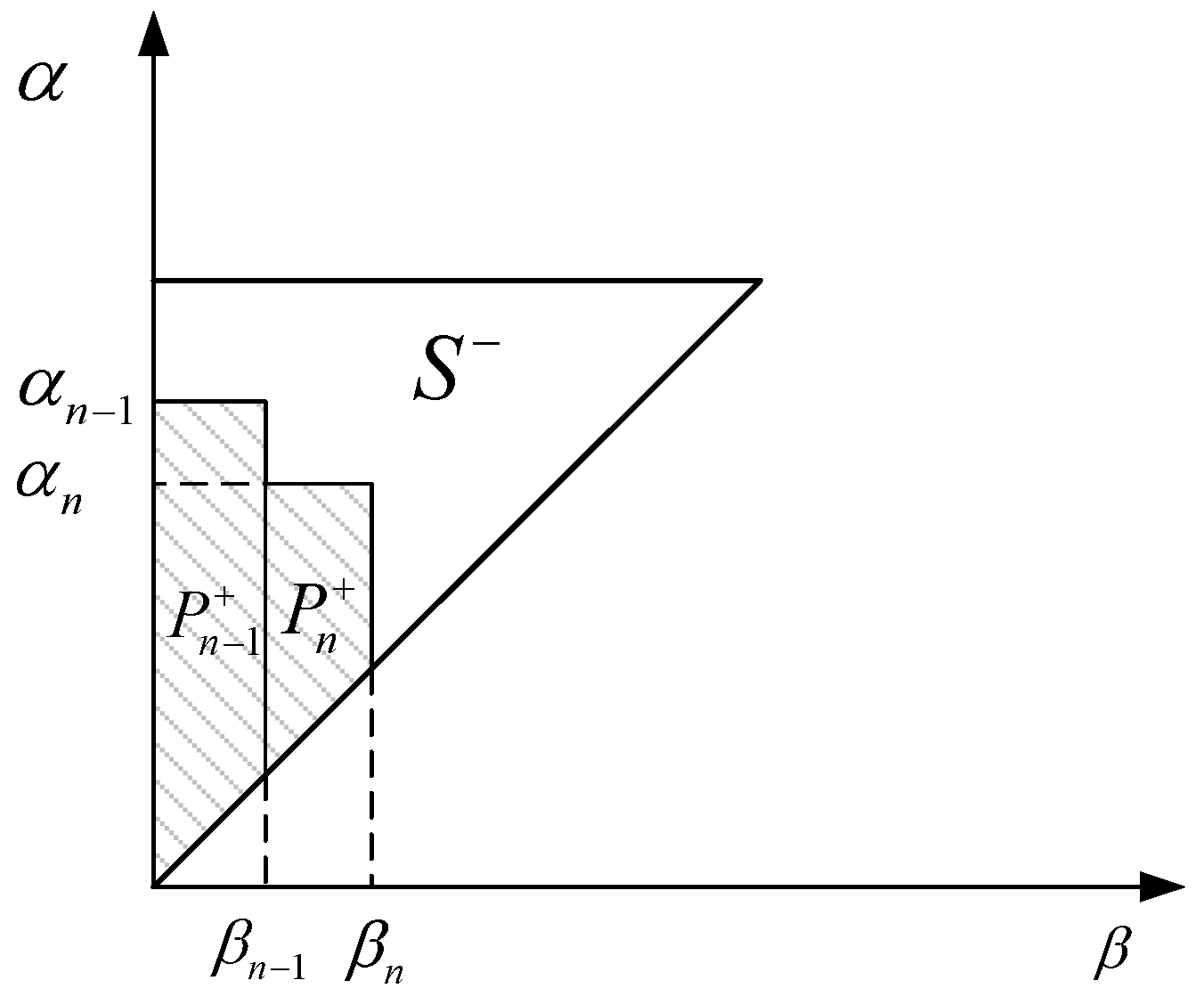



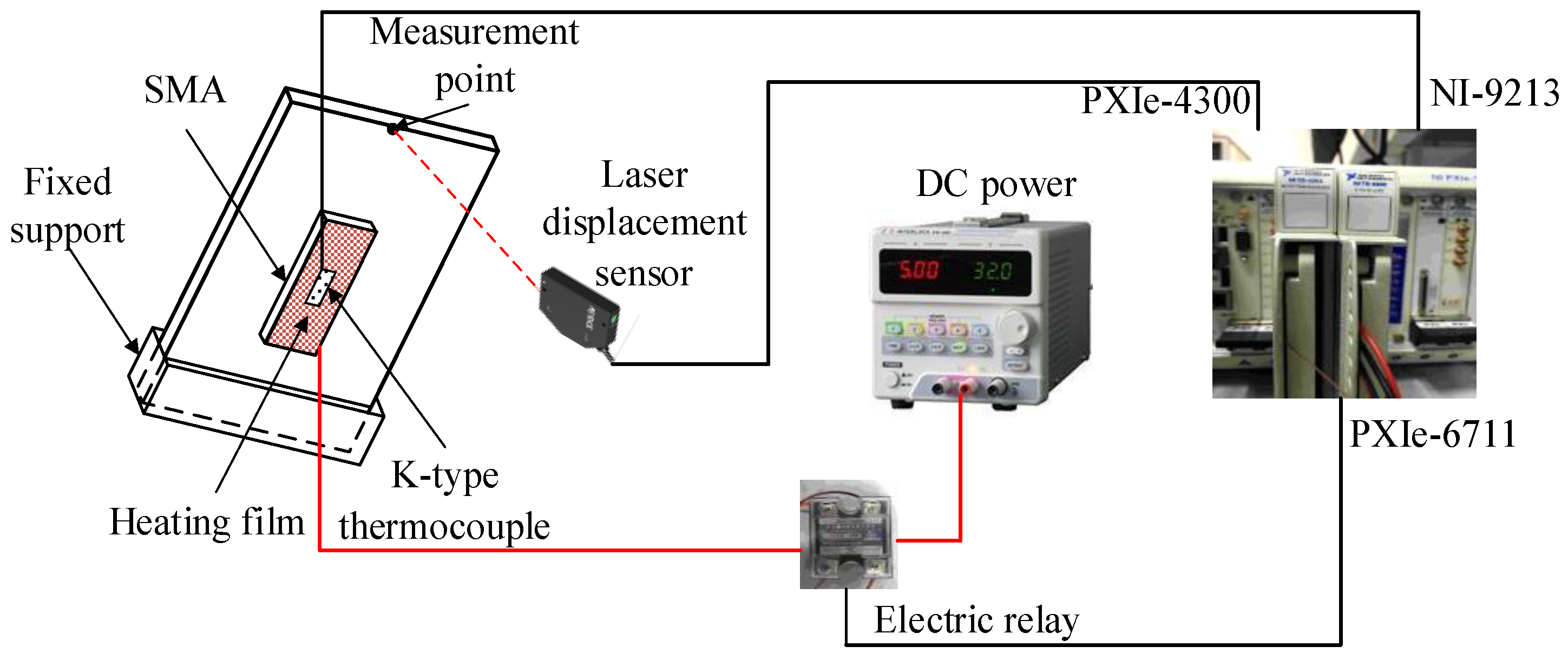
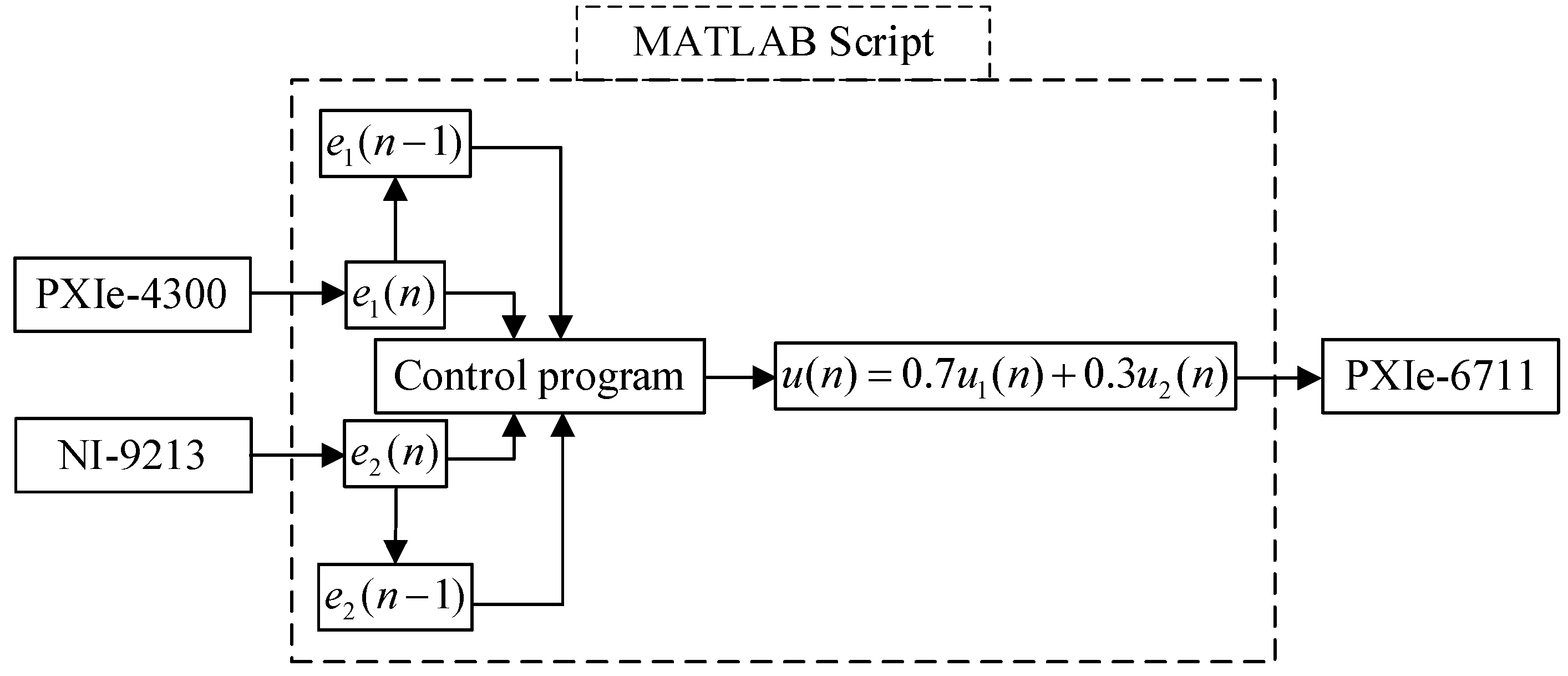

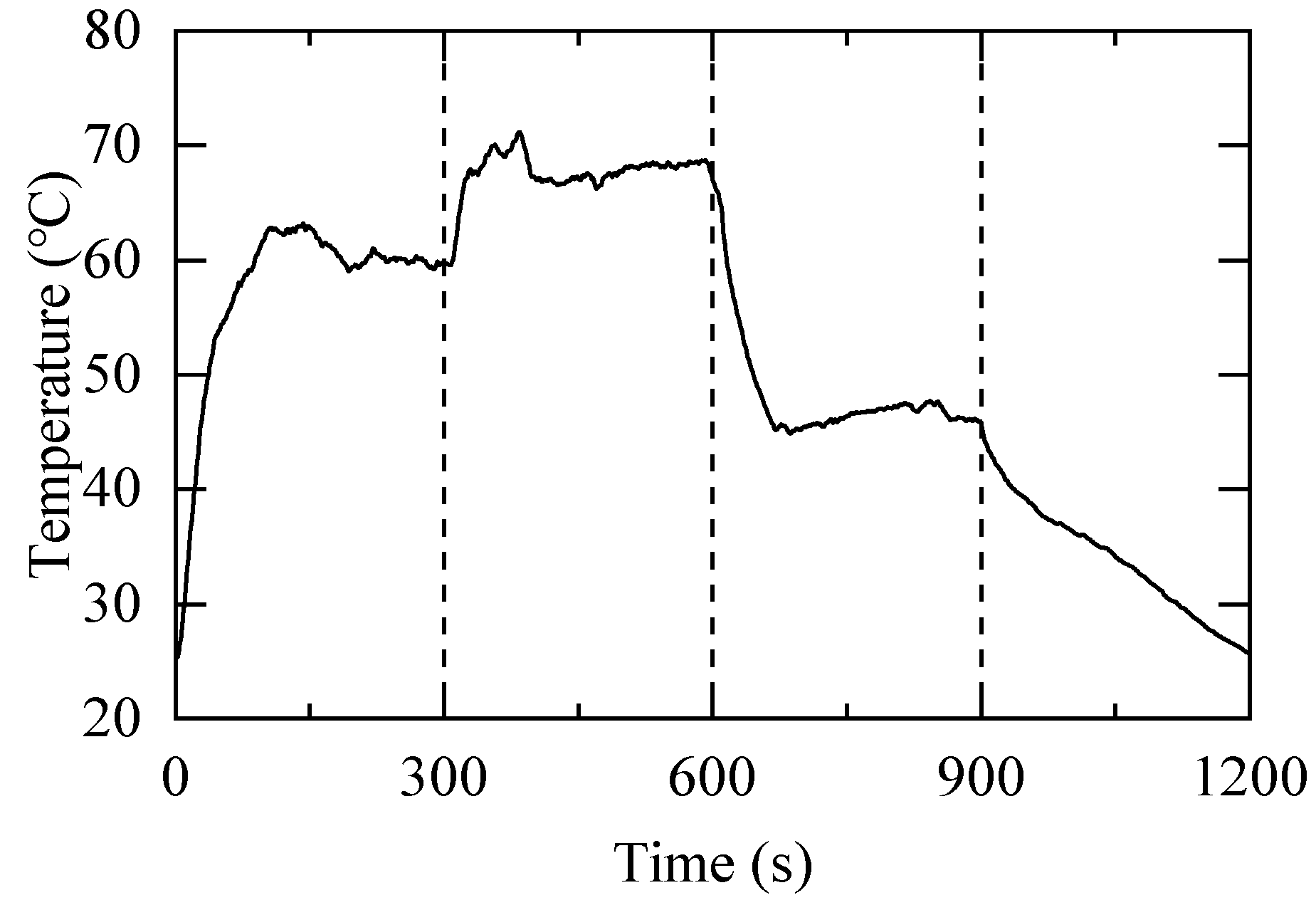

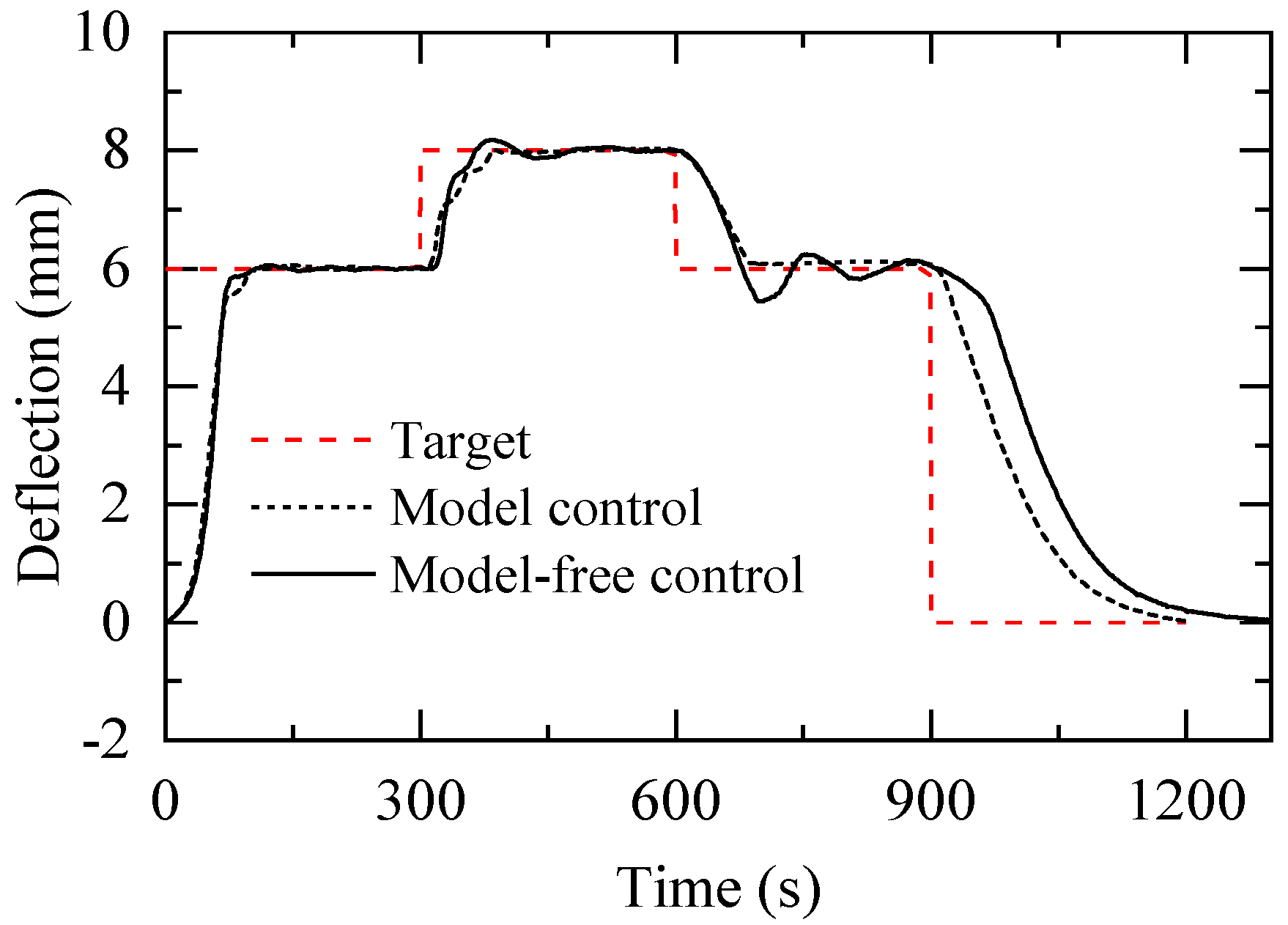
| Property | Value | Property | Value |
|---|---|---|---|
| Mf (℃) | 40 | EM (GPa) | 11.4 |
| Ms (℃) | 20 | EA (GPa) | 18 |
| Af (℃) | 73 | Poisson’s ratio | 0.33 |
| As (℃) | 57 | Density (g/cm3) | 6.5 |
| Step | Training Procedure |
|---|---|
| 1 | Load the SMA strip in martensite state to 7% of its original length; |
| 2 | Heat it above Af and below Md in the constrained condition; |
| 3 | Cool it below Mf in the constrained condition; |
| 4 | Repeat Step 2 and Step 3 several times; |
| Step | Deflection (mm) | Temperature Range (°C) |
|---|---|---|
| 1 | 0–6 | 25–60 |
| 2 | 6–8 | 60–69 |
| 3 | 8–6 | 69–45.5 |
| Control Method | Step | Steady-State Time (s) | Steady-State Error (mm) | Relative Error (%) |
|---|---|---|---|---|
| Modeled control | 1 | 106 | 0.066 | 1.10% |
| 2 | 97 | 0.045 | 2.25% | |
| 3 | 87 | 0.109 | 5.45% | |
| Model-free control | 1 | 138 | 0.051 | 0.85% |
| 2 | 183 | 0.053 | 2.65% | |
| 3 |
Disclaimer/Publisher’s Note: The statements, opinions and data contained in all publications are solely those of the individual author(s) and contributor(s) and not of MDPI and/or the editor(s). MDPI and/or the editor(s) disclaim responsibility for any injury to people or property resulting from any ideas, methods, instructions or products referred to in the content. |
© 2023 by the authors. Licensee MDPI, Basel, Switzerland. This article is an open access article distributed under the terms and conditions of the Creative Commons Attribution (CC BY) license (https://creativecommons.org/licenses/by/4.0/).
Share and Cite
Liu, R.; Zhang, C.; Ji, H.; Zhang, C.; Qiu, J. Training, Control and Application of SMA-Based Actuators with Two-Way Shape Memory Effect. Actuators 2023, 12, 25. https://doi.org/10.3390/act12010025
Liu R, Zhang C, Ji H, Zhang C, Qiu J. Training, Control and Application of SMA-Based Actuators with Two-Way Shape Memory Effect. Actuators. 2023; 12(1):25. https://doi.org/10.3390/act12010025
Chicago/Turabian StyleLiu, Renhao, Chen Zhang, Hongli Ji, Chao Zhang, and Jinhao Qiu. 2023. "Training, Control and Application of SMA-Based Actuators with Two-Way Shape Memory Effect" Actuators 12, no. 1: 25. https://doi.org/10.3390/act12010025





